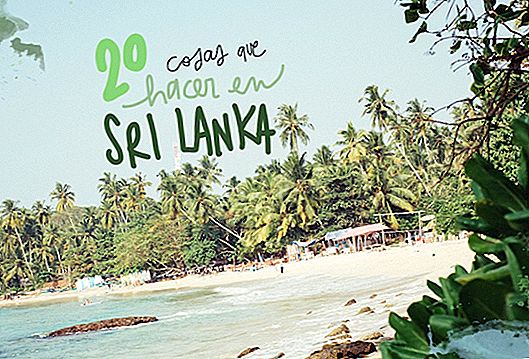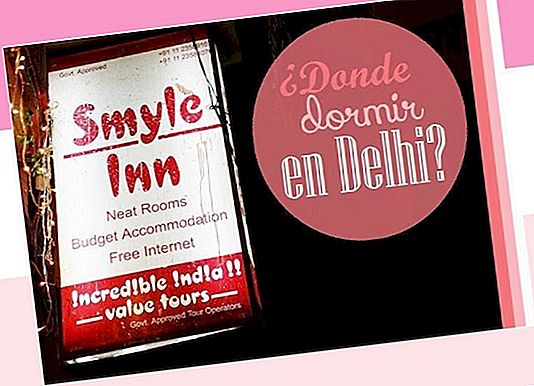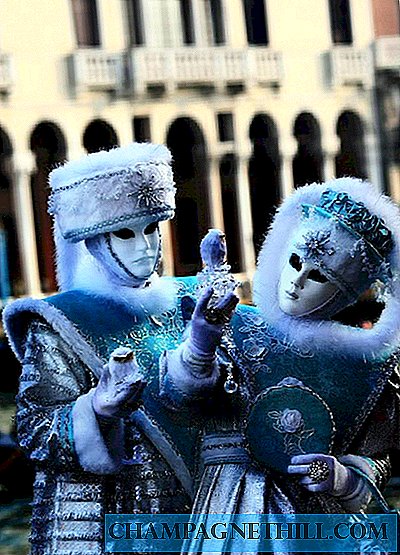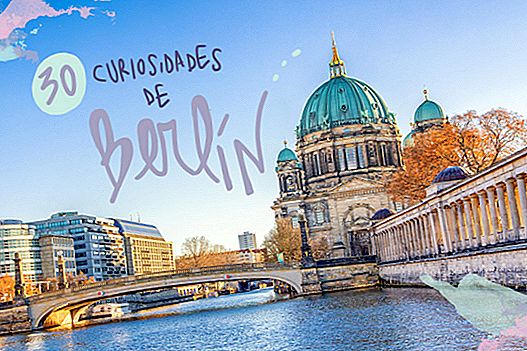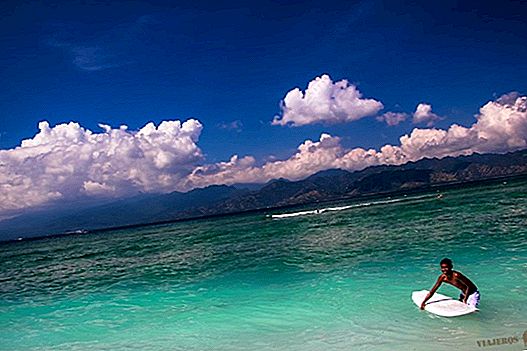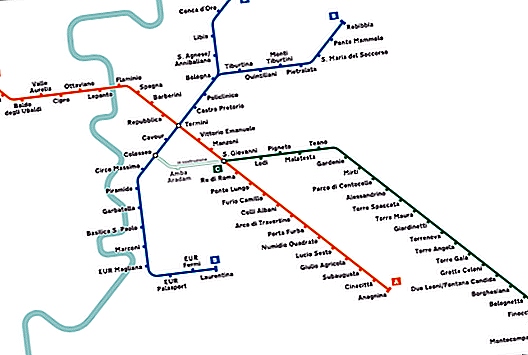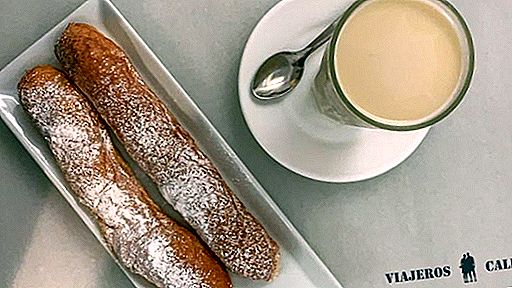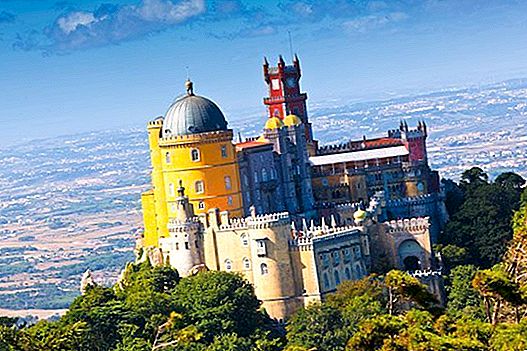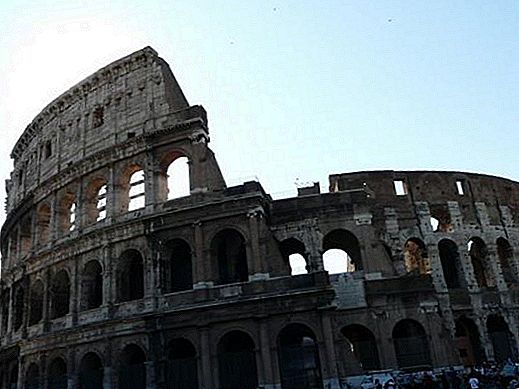Rome, the eternal city with a history and monuments impossible to overcome by any other city in the world. Rome is full of charming corners, from churches, squares, streets, neighborhoods such as Trastevere where it is a delight to get lost or rest after a long walk. In this guide of what to see in Rome in 6 days we wanted to visit what we consider essential for a first visit.
Day 1: GERONA - ROME
 Thursday, June 19, 2008
Thursday, June 19, 2008
We fly with Ryanair to Rome Ciampino airport and from there with the Ryanair bus we go to Termini station. The hotel is about 200 meters away, so we will rest directly, that tomorrow we have many things what to see in Rome.
Book your transfer Airport⇆Roma here
Make your hotel reservation here: Cherubini Hotel
Day 2: ROME (Piazza Republica, Trevi Fountain, Pantheon, Piazza Navona, Campo de Fiori, Piazza Venezia, Piazza Spagna)
 Friday, June 20, 2008
Friday, June 20, 2008
Depending on the visits you make it can be interesting, to save money and wait in line, buy the Roma Card and Omnia Vatican.
We start in the Piazza Republica where Sta. María della Vittoria is located where the wonderful and ornate baroque church is located where The Ecstasy of St. Teresa is located, a great sculpture by Bernini, well known to art scholars and those who have read Angels and demons.
During the suit to the square we see the Fontanas del Mosé (Moisés) in the square of San Bernardo, the Fontana de Tritone in the square of Barberini, and the square delle Quatro Fontane, where there is a fountain in each of the four corners .
We begin to realize that Rome is the city of fountains.
Then we visit the Quirinale Palace, which is the official residence of the President of the Republic and one of the things what to see in Rome.
It was built in the 1570s in order to be the papal summer residence for three centuries, until under threats it was ceded to the new sovereign in 1870 and later to the president of the Republic in 1946.
The next point was one of the most anticipated Trevi Fountain, it is hidden between streets, you do not see it until you are very close to it and you are speechless. We also run into the first mass of tourists taking pictures with all possible poses with the background fountain.
The Trevi Fountain was designed in the 18th century by the architect Nicola Salvi and carried out over a period of thirty years, the Fontana is an exaltation of water as a symbol of life, well-being and change. Its location indicates the limit of the path of the old aqueduct of the Virgin Water (year 19 BC), whose story is told in the reliefs of the upper part of the facade.
The spell of the Trevi Fountain is amplified by the contrast between its remarkable dimensions and the small square where it is located, as it almost seems to oppress it. The personification of Ocean in the center of the fountain seems to emerge from the water on a car pulled by sea horses and newts, among pitfalls where thirty different varieties of plants are represented.
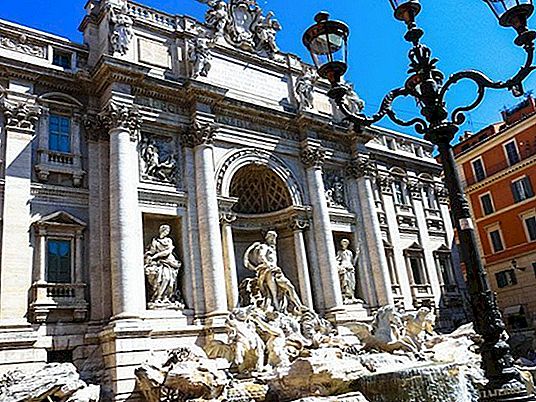
Fontana di Trevi
Then we saw the Montecitorio Palace that was erected by Bernini in 1653, although the only thing that remains of his work is the clock tower, the columns and the windowsills.
In the Piazza di Pietra we find the Temple of Hadrian that currently houses the Rome Stock Exchange, but which was formerly the headquarters of the Vatican trade, in the seventeenth century. It was erected by Antonio Pio in the year 145 A.D. Currently only the Corinthian colonnade is preserved
Another important monument is the Pantheon, one of the most impressive masterpieces of architecture of all time, was built at the time of Emperor Hadrian, in the second century AD. C., as a temple dedicated to all gods. What impresses most is its dome, whose width and height are identical, 43'30 meters, so that in the Pantheon a perfect sphere would fit. The lighting is achieved by a hole in the dome, the oculus. The interior is restored preserving the Roman design and there are a series of tombs of illustrious characters, such as Rafael.
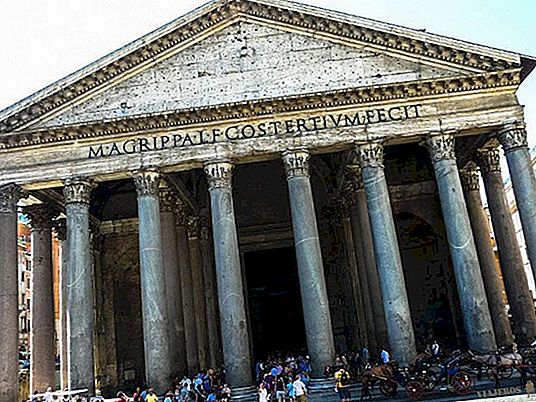
Pantheon of Agrippa, one of the wonders of what to see in Rome in 6 days.
We had a beer and a soda in the Plaza della Rotondo where it is located and the bill went to cry, after that we looked a little more where we sat.
Just to the right of the Pantheon, you can stumble upon a curious sculpture in Piazza della Minerva: it is an elephant that is the basis of an obelisk covered with geroglyphs.
Nearby there is also Piazza Navona, one of the most scenic squares of Baroque Rome, where the fountain of the Four Rivers stands out, Bernini's work, and the church of Santa Agnes in Agony and the Pamphilj palace, in whose performance he collaborated Bernini's "rival": Borromini. The giants of the fountain, in the central part of the square, opened in 1651, represent the four rivers known at the time as the largest in each continent: the Río de la Plata, the Danube, the Ganges and the Nile.
We walked to Campo de Fiori where there is a market.
Another interesting source is the Fontane de las Tortuga which is located in the square of Duke Mattei, who commissioned the fountain from Tadeo Landini in 1585, later, in 1658, Bernini added the turtles.
Near there was the church of Santa María in Campitelli, the heat of Rome at this time is quite insufferable especially at noon, all you have left is to get into the churches to cool off, we were there for a while.
When it was less hot we went to see the Church of the Gesù located in the Plaza del Gesù, it is the mother church of the Society of Jesus, known as the Jesuits, an order of the Catholic Church. Its facade is recognized as the first truly baroque and was the model of countless Jesuit churches throughout the world, especially in the Americas.
And from there we went to the Plaza Venecia, one of the Roman squares with more life and crowd in which stands the great Nazionale Monument to Vittorio Emmanuele II, the largest monument in Italy. At the foot of the statue is the altar of the homeland, the tomb of the unknown soldier fallen in the war of 1915-1918.
We climb via Vía del Corso, central axis of the Centro Stórico, which begins in Piazza Venezia and ends in Piazza Popolo. On the right and left you will not fail to find impressive churches, magnificent buildings and streets with a typical Italian flavor in which you can get lost without fear.
We left via del corso to see the Plaza de España and its no less famous staircase of Trinitá del Monti, we could not sit because there was a military-type performance, The famous staircase, projected in the year 1700 by Francesco De Sanctis, resolved in a way The angry question of the connection between the square, which for a long time was controlled by the Spaniards, who had their embassy there, and the "French zone", in the upper part, with its Renaissance church of the Trinità dei Monti.
In the Piazza del Popolo where are the twin churches and the Sta. Mª dl Popolo and its famous Capella Chigi.
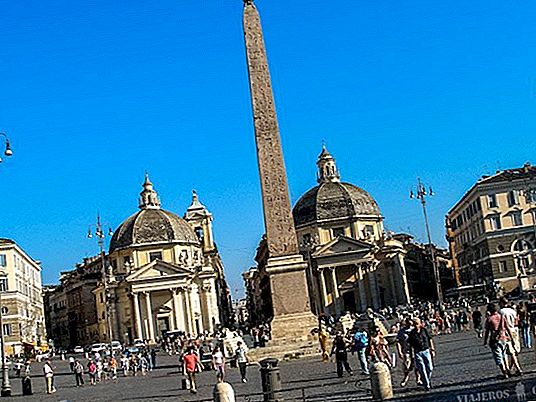
Piazza del Popolo
Make your hotel reservation here: Cherubini Hotel
Day 3: ROME (Colosseum and Palatine, Roman Forum, Circus Massimo, Santa María in Cosmedin, S. Ignacio de Loyola, Tiber Island)
 Saturday, June 21, 2008
Saturday, June 21, 2008
To start the day nothing better than seeing the Roman Colosseum, one of the many things what to see in Rome, but perhaps the best known and the most spectacular. Authentic architectural marvel of antiquity and a symbol of the Eternal City throughout the world, the Flavio Amphitheater (or Colosseum) is the largest and most spectacular building built in Roman times to house the famous gladiatorial and wild fights.
You can make the visit for free or take a guided tour Colosseum + Forum + Palatine in Spanish, so you don't miss any details and save your queues. Another good option is to book the offer that also includes a visit to the Vatican with a guide in Spanish and save money.
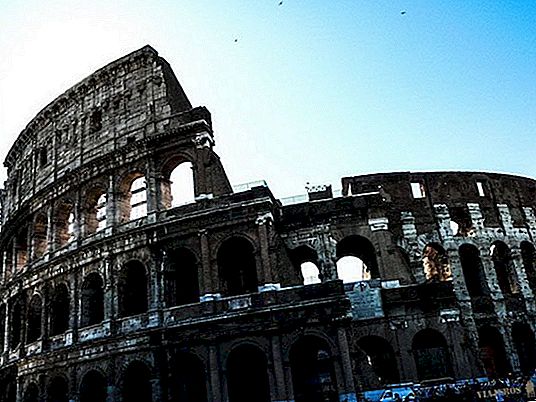
Rome Coliseum
It was built in 8 years (72-80 AD) by the Flavia dynasty on the land occupied by the artificial lake of the Domus Aurea for Nero, after a fire in Rome (64 AD) The town occupied an extension of a square Roman mile (1,480 m2) between the hillsides, colle, called Celio and Palatine.
100 days of games were celebrated for the inauguration of the Colosseum. The 60,000 spectators that fit in the colossal building entered through the 80 numbered arches open at ground level and, having spent all day in it, could all leave in just 20 minutes.
More information in this article of the Roman Colosseum, skip-the-line tickets and guided tour.
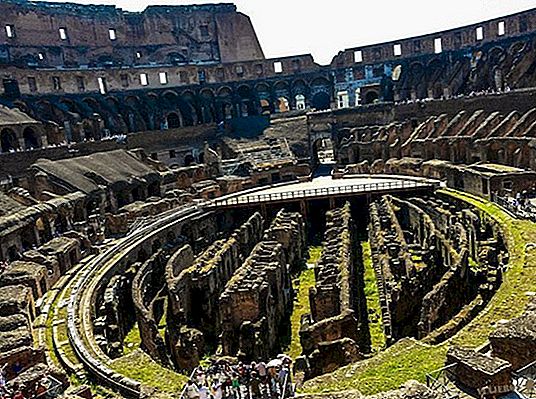
Interior of the Colosseum
In front of the Colosseum we see the Arch of Constantine of the year 315.
Nearby there is Mount Palatine which is one of the oldest parts of the city and today is a large open-air museum. There are two entrances, one near the Arch of Titus in the Roman forum and the other on Via di San Gregorio, the street that is just behind the Arch of Constantine, 200 meters away from him, away from the Colosseum. There you can see the Domus Flavia's palace extends throughout the Palatine and overlooks the Circus Maximus and also the House of Livia where Augustus's wife lived. From this part there are good views of the Colosseum and the Roman forum. There we met a couple of Spaniards who had agreed on a trip to Turkey and it would not be the first time.
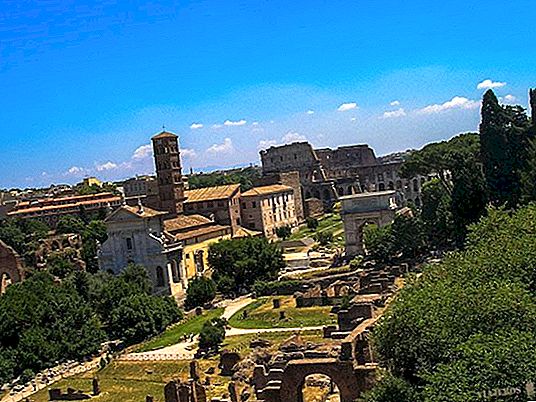
Roman Forum from the Palatine
This part you have to have a lot of imagination to see how life was there ja that the ruins are very deteriorated, not so in the Roman Forum that is located below the Palatine. The Roman Forum was once the epicenter of the life of Rome in the Republican era and in which trade, business, prostitution, religion and the administration of justice took place. This field of ruins has twelve centuries of Roman history printed on its floor.
Between the constructions that constituted it they emphasize the basilicas, where the judgments were carried out, the temples dedicated to gods and some arcs of certain triumphs. Here if you move at that time, you can get to see: Temple of Castor and Pollux, Temple of Jupiter, Temple of Romulus, Temple of Saturn, Temple of Vesta, Temple of Venus and Rome, Basilica Emilia, Basilica Julia, Arch of Septimius Severus, Arch of Titus ...
More information in this Roman Forum article, skip-the-line tickets and guided tour.
We cross the entire forum and go out through an arch near the Venice Square. Near there there is the Trajan Forum. This spectacular complex is the largest Forum in Rome. It has the arcaded square, the Ulpia Basilica, the Trajan column and the Temple of Trajan.
The forum of Trajan is chronologically the last of the imperial forums of Rome and was built by order of Emperor Trajan with the spoils of war brought after the conquest of Dacia. The Trajan's Column is also found, it is preserved in perfect condition, at the top of the Column was the statue of Trajan, at the will of Pope Sixtus V it was changed to that of St. Peter in the year 1587.
From there we went to visit the Mamertine Jail that in the days of Ancient Rome (at the end of the Republic and the beginning of the Empire), despite its small dimensions, it became the fortress-prison where the enemies of the State.
We go down the Via dei Fori Imperiali that connects the square of Venice with the Colosseum and where you can see the Trajan's Markets that are very well preserved. In the market it was stored from wine to sea fish that was preserved in nurseries.
Behind the palatine there is Circus Massimo, it was once the largest show building built in all times. Its dimensions on the outside were 610 meters long by 200 wide, while inside they were approximately 564 meters by 85 wide.
Today it is nothing more than an open field covered with bushes of which very little is conserved, among them the spina in which statues and columns were raised, around which the cars ran, a small disappointment.
After kicking the entire maximum circus we arrived at the church of Santa María in Cosmedin to see Bocca della Veritá, which is an old pavonazzetto marble mask.The sculpture, dated around the 1st century, has a diameter of 1.75 meters and represents a male face with a beard in which the eyes, nose and mouth are pierced and hollow. Put your hand inside your mouth say it brings good luck, all you have to queue and wait a good time.
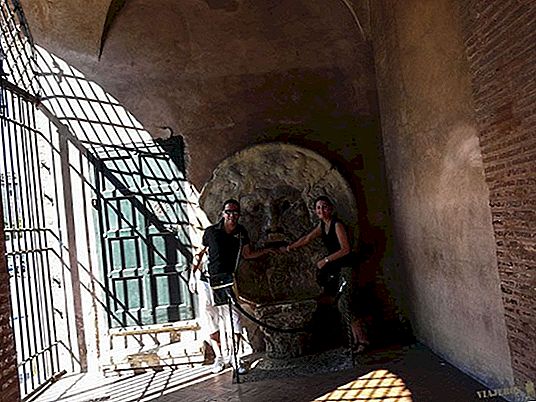
Bocca dell Verita
Nearby there is the island of Tiber to take a pleasant walk until sunset. It is associated with the sick, already in the year 293 BC. A temple to Aesculapius, god of health, was erected on the island, and a hospital is currently maintained. The church of San Bartolomé has a beautiful bell tower from the 10th century, visible from the banks of the Tiber.
A good option to end the day and see Rome at night is to book this tour with a guide in Spanish that passes through the best-lit buildings and squares in the city.
Make your hotel reservation here: Cherubini Hotel
Day 4: ROME (Catacombs San Calixto, Santa Maria Maggiore, San Pietro in Vincoli, Scala Sancta and Sancta Sanctorum, San Giovanni in Laterano, Termas de Caracalla ...)
 Sunday, June 22, 2008
Sunday, June 22, 2008
We start the day with the visit to the church of St. Mary the Maggiore the fourth and last patriarchal church of Rome and one of the things what to see in Rome and that you can not miss. Where Bernini's tomb is located, it was founded in the fourth century and is one of the 5 great basilicas of ancient Rome. The only one of the major basilicas that has managed to preserve its original structure, although over the centuries it has gained some modifications, its plant its original Christian form, standard for V century Rome, a tall and majestic cube, with wide corridors on the sides and a round apse at the end.
The second church was San Pietro in Vincoli where we found the famous statue of Michelangelo's Moses, completed in 1515 and originally conceived as part of the independent funerary monument of Pope Julius II along with 47 more statues, it became the central core of the monument and tomb of the pope in San Pietro, his family's church. Moses is presented with horns, due to the similarity in Latin between the words "lightning" and "horn." This type of iconographic symbolism was common in the sacred art of the Renaissance, and in this case, it facilitated the work of the sculptor (since sculpting horns is much more concrete than sculpting abstract light), and those who saw it would understand it as the glow from the face of Moses, and not like horns
Then we went to see the Catacombs of San Calixto, for this we took a bus at Termini station to San Giovanni in Laterano square and from there another to the tombs, there by surprise we met the couple of tourists from Turkey, with how big Rome was and we had already agreed twice, we visited with them.
You can also make the visit by booking a guided tour in Spanish that includes the Via Appia or this tour of Christian Rome and the catacombs with a guide in Spanish.
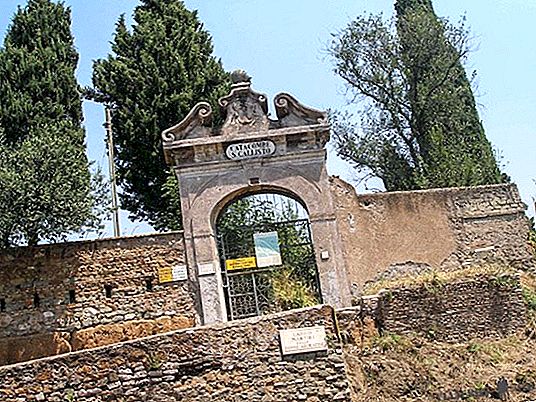
San Calixto Catacombs
There are many catacombs on the outskirts of Rome but these are the most interesting are with its more than 22 km of galleries distributed on different floors, and that reach a depth greater than 20 meters, richly decorated and where there are burials of the first potatoes ( 16) and martyrs like Santa Cecilia. They receive their name from deacon San Calixto, appointed at the beginning of the third century by Pope Ceferino as administrator of the cemetery. In this way, the catacombs of San Calixto became the official cemetery of the Church of Rome.
After an explanation at the entrance they take you inside with a guide, you can't get away much because losing yourself there would be difficult to get out again. The Roman catacombs the truth that disappointed us a little and more when we saw the day after the Vatican but if you do not have this option is always good as an experience and not to pass heat.
We returned with the bus to the Plaza de San Giovanni in Laterano and a few meters from the Basilica of San Giovanni in Laterano is the Sancta Sanctorum chapel. It was the main chapel used by the first pontiffs and was moved from the Lateran Palace, former papal headquarters and adjacent to the Basilica of San Juan de Letrán, to the current building, a few meters away.
Book the best rated tours and excursions in Spanish in Rome by travelers:
- Offer: Vatican + Colosseum, Forum and Palatine
- Guided tour of the Vatican
- Guided tour of the Colosseum, Forum and Palatine
- Night tour of the illuminated Rome
- Excursion to Naples and Pompeii
- More excursions and tours here
The Chapel contains an archipelago image (not painted by any human being) of Christ.
We can also see the Scala Santa, a staircase of 28 marble steps that are covered by a wooden covering. It is said that the Holy Scala is the staircase by which Jesus climbed to the palace of Pontius Pilate in Jerusalem.
It is only possible to climb the 28 steps of the Scala Santa on your knees and if you want to climb on foot it must be done by stairs located at the end of the Santa Scala.
In this same square we can visit San Giovanni in Laterano, the cathedral of Rome, highlight the portico and the sculptures of Jesus and his Apostles, it is immense.
After we went to see the Baths of Caracalla by bus, the baths were a large bath complex of imperial Rome. They were built in the city of Rome between 212 and 216 AD, during the reign of Emperor Caracalla, they were inaugurated with the name of Antonine Baths, since Emperor Marco Aurelio Antonino Basiano was never known in life with the name of Caracalla. The best are the mosaics that are still preserved. Several of the gigantic marble bathtubs, sculpted in a single block, moved to the center of Rome to be used as fountains.
Already in the afternoon we went to the Piazza del Campidoglio remodeled according to Michelangelo's design, behind the Roman forum, where there are the Capitoline museums that contains the oldest art collection in Europe and is the oldest museum in the world. Among the outstanding sculptures are the seventy-nine busts of Greek and Roman philosophers, plus the sixty-four that comprise the collection of emperors. "The Venus Capitolina" and the "Dying Gaul", marble copies of Hellenistic Greek originals, the wolf with Romulus and Remus or the Spinal are the most admired among the great sculptures.
More practical information to prepare your trip to Rome
- The 5 best tours and excursions in Rome
- 100 things to see and do in Rome
- 20 essential places to visit in Rome
- Practical guide to travel to Rome for a weekend
- Rome guide in 3 days
- Rome guide in 4 days
- Travel guide to Rome step by step
- The best tips for traveling to Rome
- Vatican Museums - Skip the line tickets and guided tour
- Roman Colosseum - Skip the line tickets and guided tour
- 5 places to visit in the Vatican
Day 5: ROME (Vatican Museums, St. Peter's Square and Basilica, Castel Sant 'Angelo, Trastevere)
 Monday, June 23, 2008
Monday, June 23, 2008
We wake up early and still with many things what to see in Rome, we took a bus to the Conciliation that connects the Vatican with the castle of Sant Angelo Castle, and there is an elevated passageway that connects them, it was used for centuries, the Popes, in case their lives were endangered, could flee from the Vatican palaces through a secret passage 800 meters long and about ten meters high that led them to the fortress of Sant'Angelo.
We traveled the road to the Plaza de San Pedro, there were few people and we could visit the square and the Basilica of San Pedro quietly, the current basilica is the result of a work developed over several centuries. It began as a memorial, in the place where St. Peter was martyred and buried. There you can see the splendid dome of Michelangelo, the famous Piedad also by Michelangelo, the only work signed by the artist, who sculpted at 24 years old in a single block of marble, the baroque canopy of the main altar, created by Bernini with bronze taken from the Pantheon, and the bronze statue of St. Peter, the work of Arnolfo di Cambio. After finishing the visit I decided to go up to the Dome, to see the views of the Plaza San Marco and Rome from above, although the climb is hard, the views are incredible with the statues of 11 of the Apostles (except Judas Iscariot), San Juan Bautista and, in the center, Christ.
You can make the visit for free or book this guided tour of the Vatican in Spanish, to not miss any details and save your queues.
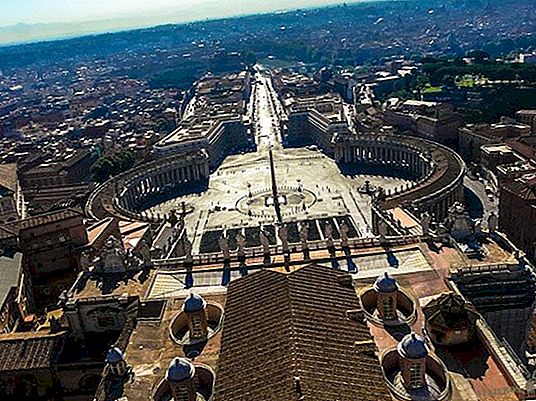
Rome from St. Peter's Basilica
We had booked a visit to the Vatican Catacombs well in advance and we had time for 2:30 pm so we took the opportunity to visit the Vatican Museums and especially the Sistine Chapel, to get there you have to leave the square and go around the cathedral, there you will find a long line, it takes between half an hour and an hour to enter. Museums are the result of centuries of collecting and papal commissions, offering a wide variety of collections that include ancient Greek and Roman art pieces (the Vatican is the world's largest collection of these characteristics); of Egyptian, Etruscan art and, of course, the great masterpieces of Renaissance art, with the frescoes of the Sistine Chapel and the so-called "Raphael's Rooms". We toured the museum I liked the part where the maps of antiquity come out. Until we arrived at the Sistine chapel, it is enormous how I imagined it, the restoration of the twenty-year-old Sistine Chapel restored the brightness of its original colors and allows us to fully enjoy, and in detail, the episodes Biblical in the vault, and the Last Judgment of Michelangelo, with its almost 400 figures represented at the most dramatic moment in the history of mankind, on the roof you will see one of the most representative figures “The creation of Adam” we At first we did not see it but after reviewing the photos we realized and came back to admire the masterpiece. To say that photos are not allowed, but there are many people and very few vigilantes and many of the people with the focus off cast them out. I cast very few and the truth was quite crooked.
More information in this article of the Vatican Museums, skip-the-line tickets and guided tour.
We finished the visit of the museums and we went to eat. We had one of the most anticipated visits in the archaeological zone under the Vatican Basilica, also called the Vatican Necropolis. At the beginning of the 20th century, excavations were carried out here that revealed the presence of a vast necropolis, which it seems was used until the second century. The special situation of the area and the small spaces allow a limited number of people. We arrange the visit via the Internet with a Vatican office called “Ufficio Scavi”, the visit is made with a guide in Spanish, and the necropolis is visited to a part where they say there are the bones of San Pedro, below the center of the basilica and that can be seen through a hole, it is the origin because the basilica and the Vatican were built and built in the place where St. Peter suffered martyrdom and was buried. To end the visit they take you to the area of the Crypts where the Popes are buried and where you can still see kneeling people praying in front of the tomb of John Paul II. And to get out you go up to the Cathedral.
Then we descend through the Conciliation to Castel Sant'Angelo, the fortress of the popes built in the Middle Ages on the remains of the tomb of Emperor Hadrian (2nd century AD).
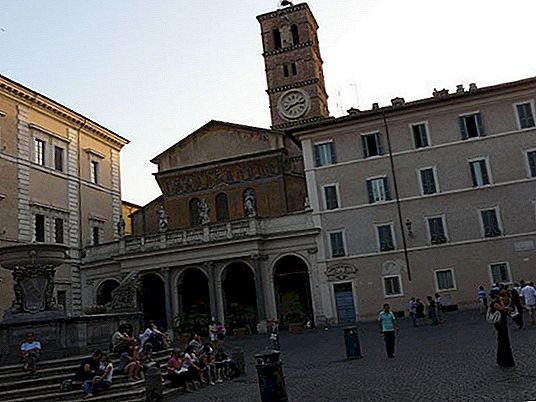
Trastevere
Nearby, taking the bus is the Trastevere neighborhood, an ideal place to stroll through colorful alleys and squares, which still retain a truly Roman character. Formerly the Trastevere - "across the Tevere", the Tiber - was the first neighborhood located on the right bank of the river; artisans, fishermen, merchants lived there, as well as the community of foreigners dedicated to port activities. We crossed it until we reached the church of St. Mary, one of the places to see in Trastevere, which we visited with its mosaics (13th century) by Pietro Cavallini, and Santa Cecilia, with the statue of the patron saint of music, work of Stefano Maderno. We sat in the square to rest, on a terrace of a bar where they made some delicious orange juices.
A good option to try delicious Italian food is to book a gastronomic tour of the Trastevere neighborhood.
Make your hotel reservation here: Cherubini Hotel
Day 6: ROME (Villa and Borguese Gallery) - GERONA
 Tuesday, June 24, 2008
Tuesday, June 24, 2008
It was our last day in Rome and as we had the afternoon flight we took the opportunity to go to Villa Borghese, there is a park, where there are gardens, fountains, several buildings, museums and attractions. There is also the Borghese Gallery, one of the most important museums in Rome and you also have to book tickets in advance, there you can see several universally known masterpieces.

Borguese Villa
There are two of Titian, Sacred love and profane love, and Venus blindfolding Cupid. Here is also exhibited one of the best religious paintings of Raphael, Christ taken to the grave (The Burial of Christ). From the same artist there is a famous portrait, The Lady of the Unicorn. An unrepeatable ensemble is exhibited from Caravaggio, perhaps the best exposed in a single museum: Young man with a fruit basket, Sick Bacchus (possible self-portrait), The Virgin and Child stepping on the snake (also called The Virgin of the Palafreneros), San Jerónimo and David with the head of Goliath which tells that Caravaggio portrayed himself in the beheaded head of the giant, Bernini's incredible statues. Visit little known but highly recommended.
To visit the museum you must book this guided tour in Spanish or buy the ticket in advance, having very limited places.
We did not stop during these 5 days but we still had things to see so we threw the coin in the Trevi Fountain to return to beautiful Rome.
The best offers of Flights to Rome here
The best hotels at the best prices in Rome here
Book the best tours and excursions in Rome in Spanish here
Book your transfer Airport⇆Roma here


 Book the best rated tours and excursions in Spanish in Rome by travelers:
Book the best rated tours and excursions in Spanish in Rome by travelers: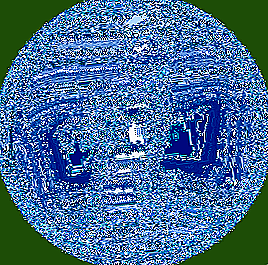
 The best offers of Flights to Rome here
The best offers of Flights to Rome here The best hotels at the best prices in Rome here
The best hotels at the best prices in Rome here Book the best tours and excursions in Rome in Spanish here
Book the best tours and excursions in Rome in Spanish here Book your transfer Airport⇆Roma here
Book your transfer Airport⇆Roma here